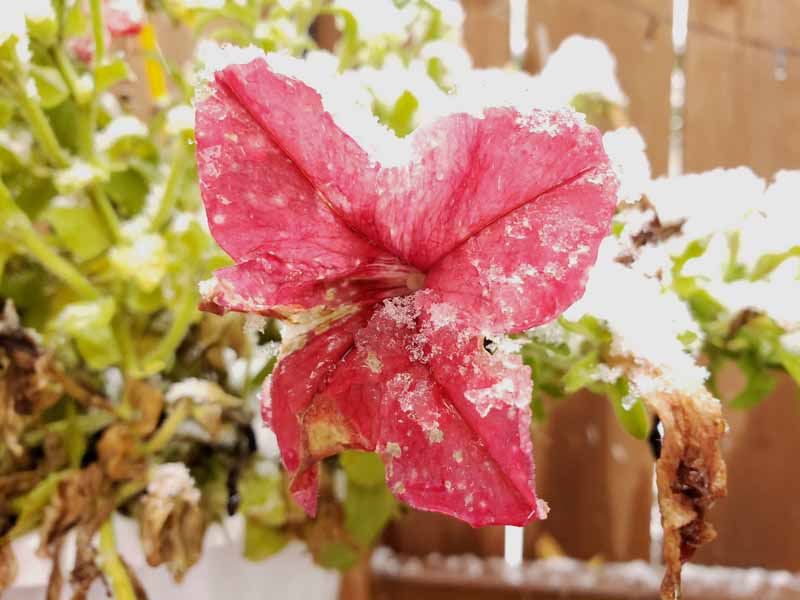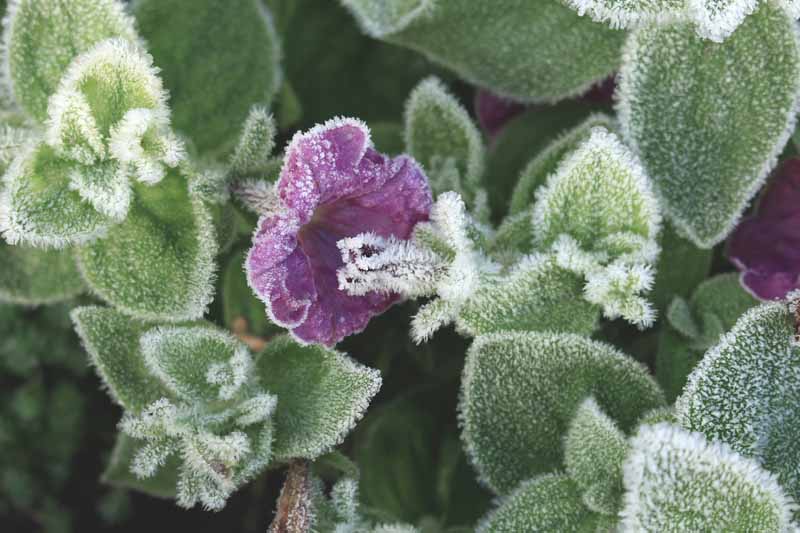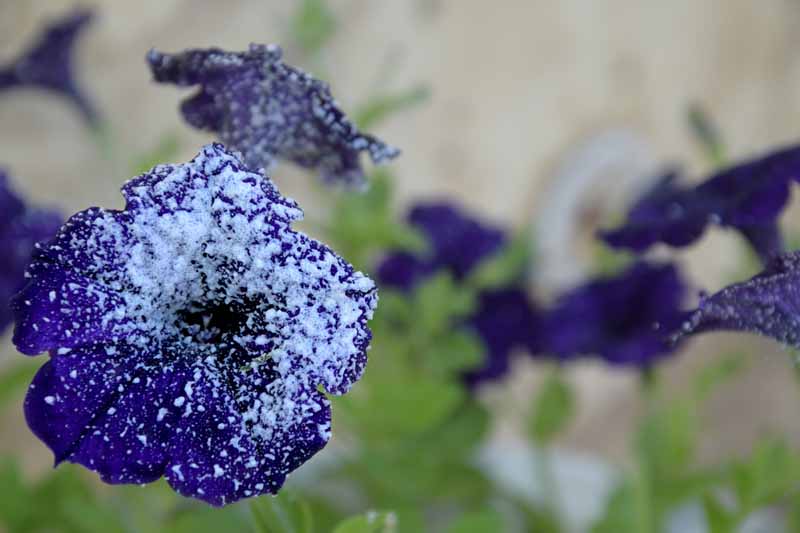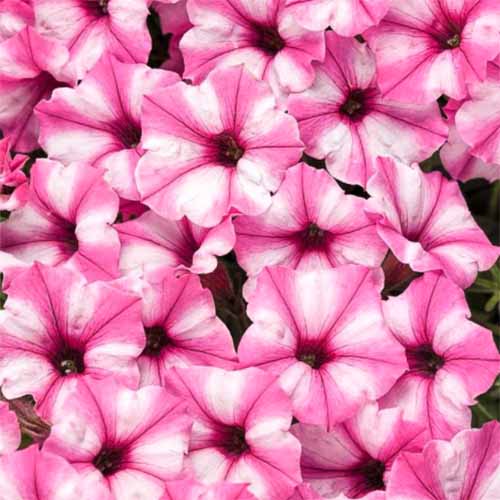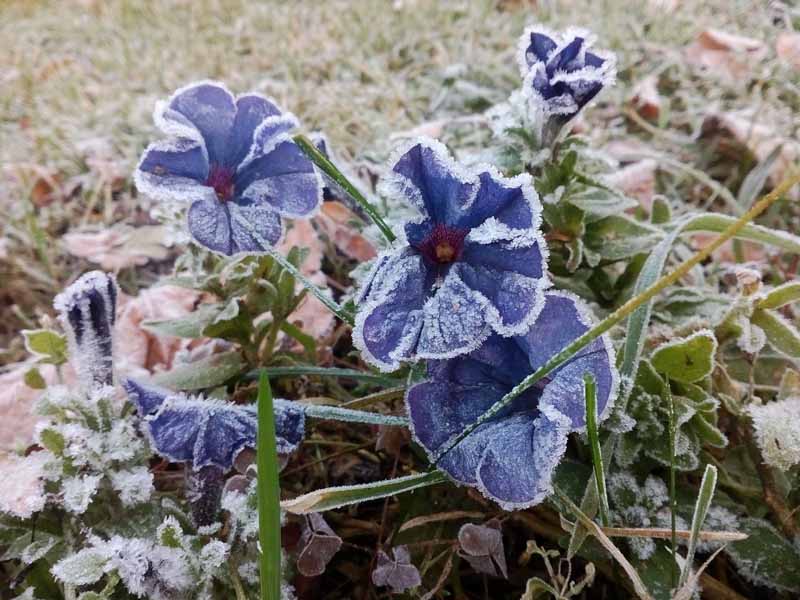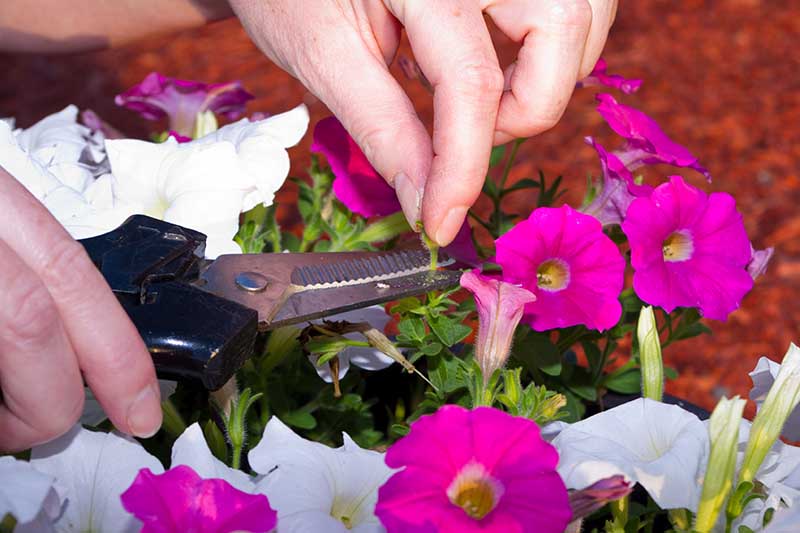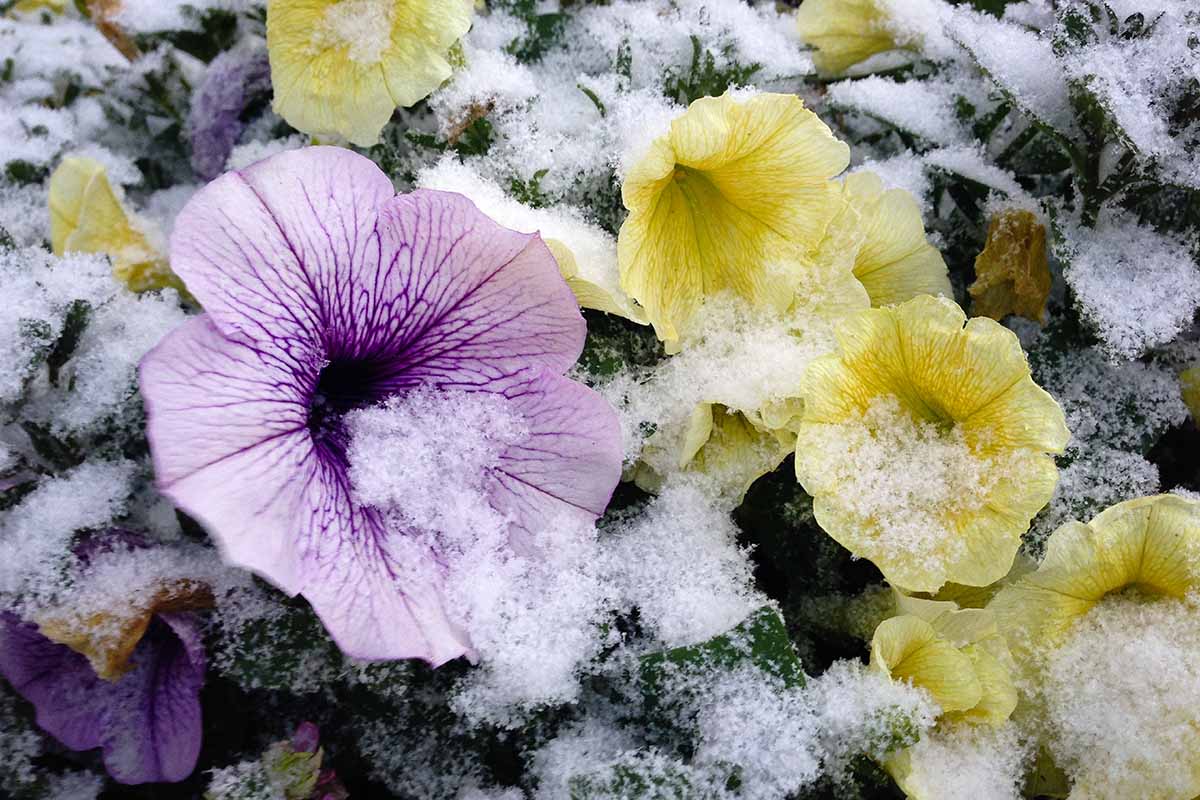While you’ll find more selections of the modern hybrid varieties than ever before, all petunias still share this “warm weather preferred” trait. They will not tolerate frost – at least not more than a touch of it. And they’re not cold hardy. We link to vendors to help you find relevant products. If you buy from one of our links, we may earn a commission. Gardeners in other areas must satisfy themselves with growing petunias outdoors as annuals. There’s more to it than that, though. Even if your flowers can’t endure once freezing weather sets in, you can prepare them to bloom well after chilly temps first arrive, and make preparations all summer to make sure they’ll stay alive as long as possible. Here, I’ll give a few pointers for those growing perennial petunias in more temperate zones. I’ll also share my tips for those in cooler areas who want to encourage petunias grown as annuals to flower for as long as possible into the fall. Here’s what I’ll cover:
Petunia Cold Tolerance
Here’s the big picture on this flower’s cold hardiness: Petunias thrive when nighttime temperatures are in the 55 to 65°F range, and daytime temps are between 61 and 80°F. They will succumb to sub-freezing temperatures in a hurry, and anything below 40°F may kill them, though Wave® petunias can tolerate temperatures as low as 35°F. Petunias may be able to survive a dusting of snow or a light frost, especially if they’ve been acclimating gradually as autumn temperatures set in.
What Is the Growing Season for Petunias?
These cottage garden and hanging basket favorites thrive in warm weather. Whether you start them from seeds indoors eight to 10 weeks before your average last frost date, or purchase transplants from a nursery, outside of Zones 9 to 11, you must wait for reliably warm weather before planting petunias out. Keep in mind that some of the tactics that will help you delay the ill effects of freezing at the end of the season don’t work early on, when the plants are immature and more likely to succumb to temperature shock. Only petunias that thrived all summer and then gradually acclimated to increasingly chilly temperatures in the fall are able to benefit from late-season efforts to keep them alive in colder weather. A full-sun location or fabric covers won’t work on newly-planted petunias facing early spring frosts, for example, even if they’re growing in containers. After all risk of frost has passed, be sure to harden off your plants before transplanting into the garden or leaving the containers out full time. To do this, set them outside in a sheltered location for one hour on the first day, then gradually increasing the amount of time they spend outdoors over the course of a week to 10 days. If an unexpected cold snap is in the forecast, bring them back indoors and start the process again once temperatures start to rise again. As for the rest of the growing season, grown as annuals, most cultivars will begin blooming in midsummer and continue all the way up until the first heavy frost hits. Find more tips on growing petunias in our in-depth care guide. Want to learn some ways to push that blooming period to the limit? Read on.
Winter Care in Zones 9-11
When you live in an area where petunias can be grown as perennials, enjoy! There’s no need to winterize them, since they won’t go dormant and should continue to bloom throughout the year. But there are a couple of beneficial chores to complete so your petunias will thrive from November to March. For example, you can prompt the plants to stay healthy and flowering by keeping up with their water needs even when the temperatures are more moderate in fall and winter. Their shallow roots usually require supplemental water to keep the soil moist six to eight inches down, which is their ideal. Garden-planted petunias may require extra water once or twice a week, but container and hanging basket petunias often need more frequent soaking, even daily when it hasn’t rained. When you grow these tender perennials year ‘round, you should also remember to apply a new layer of mulch in the garden beds or large containers in October or November. This will help to retain moisture and suppress weeds. And if you use organic material, it will decompose and help build soil that’s nutritious and well-draining. Wood chips, shredded leaves, bark, or dry grass clippings all work well. Spread the mulch about two inches thick, placing it about two inches from the center stems. This will help the shallow roots retain moisture. In the fall, it’s also a good idea to apply slow-release fertilizer granules to any containers filled with plants that haven’t been fed for six months or more. Just don’t overdo it with nitrogen, or your plants will put all their energy into foliage, not blooms. Also take a critical look at the plants at some point in late October or early November, and again every three months after that. If there are faded flowers and leggy stems, take this opportunity to deadhead or cut the stems to half their height to promote new growth. And don’t forget to cover any petunias you can’t move into shelter if an unexpected ice storm or frost is predicted. That may not save them, but it’s worth a shot. Fabric – such as burlap – coverings work best, because they keep the frost out but still allow moisture to escape so it won’t freeze on the plants. You can also use row covers, sheets, pillow cases, or light tablecloths for the job. Just make sure they touch the ground at the bottom. Anchor them with rocks or other weights. I’ve also used upended cardboard boxes to protect annuals in a pinch. Plastic will work, too, but it’s a last resort. If it touches the leaves or blooms, it can hold moisture there to freeze and destroy the tissue. When plastic is your only option, make sure to drape it over a tomato cage or other makeshift support so it doesn’t make contact with the foliage or flowers. Also remember to remove the coverings when the sun comes up or the weather warms, so you don’t inadvertently cook the plants you’re trying to protect.
Tips to Extend Blooming in Cooler Zones
Outside of Zones 9 to 11, you can still maximize the length of time these annuals stay alive, and even how long they keep blooming. Use these strategies:
2. Location Selection
This part of the plan involves some tradeoffs. Ideally, you’ll transplant or sow in a space where the plants receive at least six hours of full sun per day. For example, if you opt for spreading petunias, it’s far more difficult to cover them if there is a surprise early frost. Multiflora varieties tend to be more compact and manageable. If you’re willing to grow yours in containers, you can choose a variety that you can transport indoors for a day or two to withstand the first couple of frosts, or consider moving them indoors throughout the winter, either dormant or while continuing to put on new growth. You can learn more about how to overwinter petunias indoors in our guide. ‘Supertunia Mini Vista Pink Star’ For these portable pots, select a smaller, more lightweight type, like ‘Supertunia Mini Vista Pink Star.’ It’s available in four-packs from Home Depot. Or plant just one trailing petunia per hanging basket, so each will be light enough to move as needed when temps get cooler. This also means you can easily move the plants into the shade or AC when sweltering midsummer weather makes them flag. Shock Wave® ‘Coconut’ Shock Wave® ‘Coconut’ is one variety that will fill up a basket with a single plant. It has bright white flowers with yellow centers. It’s available in six-packs of plants from Burpee. But you can grow these flowers without quite that much sun. Even though it causes reduced flowering, planting in part shade will make the plants live longer in areas with scorching hot summers. Here’s the thing, though. As autumn closes in, it’s colder in shady areas, so the plants’ roots and stems might freeze and die more quickly than those planted in sunnier spots. The best compromise? Plant in full sun to stave off daytime exposure to those premature chilly temps, but use shade netting to reduce the ill effects of strong sun in the warm months, if that’s an issue for you. Avoid planting in low-lying areas of the garden as cold air tends to accumulate in valleys and frost is more likely. Also grow annual petunias in a spot where your flowers will be protected from wind, which can break the plants and dry the soil.
3. Deadheading
Many newer Wave® series or spreading petunias have been bred to continuously bloom without deadheading. But if you’re growing older varieties like the grandifloras, you can extend the blooming season well into the fall by diligently removing spent blooms from the plants. The idea is to remove them before they rob the plant of energy. After flowers fade, the plants will turn energy to producing seeds that could go to producing more blooms instead. Use sanitized scissors to avoid spreading disease pathogens, and snip the faded flowers where they meet the stem.
4. Pruning
It may not seem kind when you do it, but cutting the plants back to half their height in midsummer will help them grow back stronger, and bloom longer. Perform this chore when you notice the stems getting leggy and losing their leaves. Not only will the severe cut promote new growth and another round of blooms, it will make the plants sturdier, and better able to withstand chilly weather in subsequent weeks.
5. Fertilizing
When growing these annuals in the garden, start with a balanced granular fertilizer worked into the soil ahead of planting, about eight ounces per 25 square feet. In midsummer, start using liquid fertilizer once every three weeks to give petunias an energy boost. Opting for the liquid is the best option when the plants have already spread over the soil surface, which makes it difficult to scratch in the granules. Dilute the liquid and either pour it onto the soil or spray it on the leaves, according to the manufacturer’s instructions. To encourage hanging basket and container plants to flower as long as possible, add some granular, slow-acting fertilizer to the growing medium when you plant, and consider adding more midway through the growing season. The granules release nutrients gradually, which keeps the fertilizer in the pot longer. Liquid fertilizer is far more susceptible to getting washed out with the frequent watering that’s necessary for container-grown annuals. Some hanging basket aficionados do both, giving their petunias an occasional boost from liquid fertilizer sprayed on the foliage along with granules added to the soil. If you’re watering once a day or more often, this might be a good idea for your petunias, too.
6. Providing Ample Space in Containers
Container-grown varieties will flower longer and be less susceptible to chilly temperatures when they have ample space to grow in pots. Assure this space at transplant time, though the negatives of too-cramped quarters won’t be obvious until the plants get a bit larger and start competing for resources. Limiting the number you plant per container will make it easier for thirsty petunias to receive their water requirement, and will keep the soil from getting hard, too. Dry, compact soil will weaken the plants when they can’t readily draw up nutrients or water. While it’s a temptation to pack a pot or basket with transplants for “instant color,” the reality is just a few plants will fill out quite quickly. Two or three plants per 10- to 12-inch pot will create a full effect without overcrowding. In window boxes, plant compact varieties about 12 inches apart, and grow larger types 16 inches away from each other.
7. Temporary Coverings
You can’t fight Mother Nature indefinitely. At some point, your petunias will succumb to the cold if you live in an area where they must be grown as annuals, and you want to keep them outdoors. But if you’ve used some of these tactics to keep them healthy and flowering right up until the first frost, you can employ row covers to get them through the first few bouts before harsher weather sets in. Prop it up with a cage or frame so it sits a few inches above the top of the leaves and blossoms, and make sure to weight down the edges with a brick or log. Be sure to take it off before the next rain, since only a limited amount of water can make its way through the weave. Remember to remove the cover when the weather heats up again, too, both so you can enjoy the colorful blooms and so the cover won’t get the air so warm it cooks the plants. Row covers and wire cages aren’t attractive options, so save them to use as a short-term season extender. The evaluation and extra maintenance required will get you that much closer to year-round color – and well beyond your garden beds or borders! Extending the bloom period for your outdoor plants can become another component in your overall growing and design plan, and that may include potted plants, window boxes, and containers that transition between home and patio. You may also be able to extend the life of your favorite petunia plants by taking cuttings and rooting them to overwinter indoors. The next spring, you can transplant them into the garden or containers to grow outdoors. If these annuals are part of your garden plan already, it would be helpful for your fellow petunia fans if you’d share any tips you have for helping them cope with cool weather. Feel free to reach out with suggestions or questions you may have in the comments section below. And if these end-of-season tips have inspired you to learn more about growing annuals, read these popular flower guides next:
15 of the Best Annuals for Late Summer ColorFall Annuals for the SouthHow to Sow Seeds in Winter for Sweet Spring Blooms

